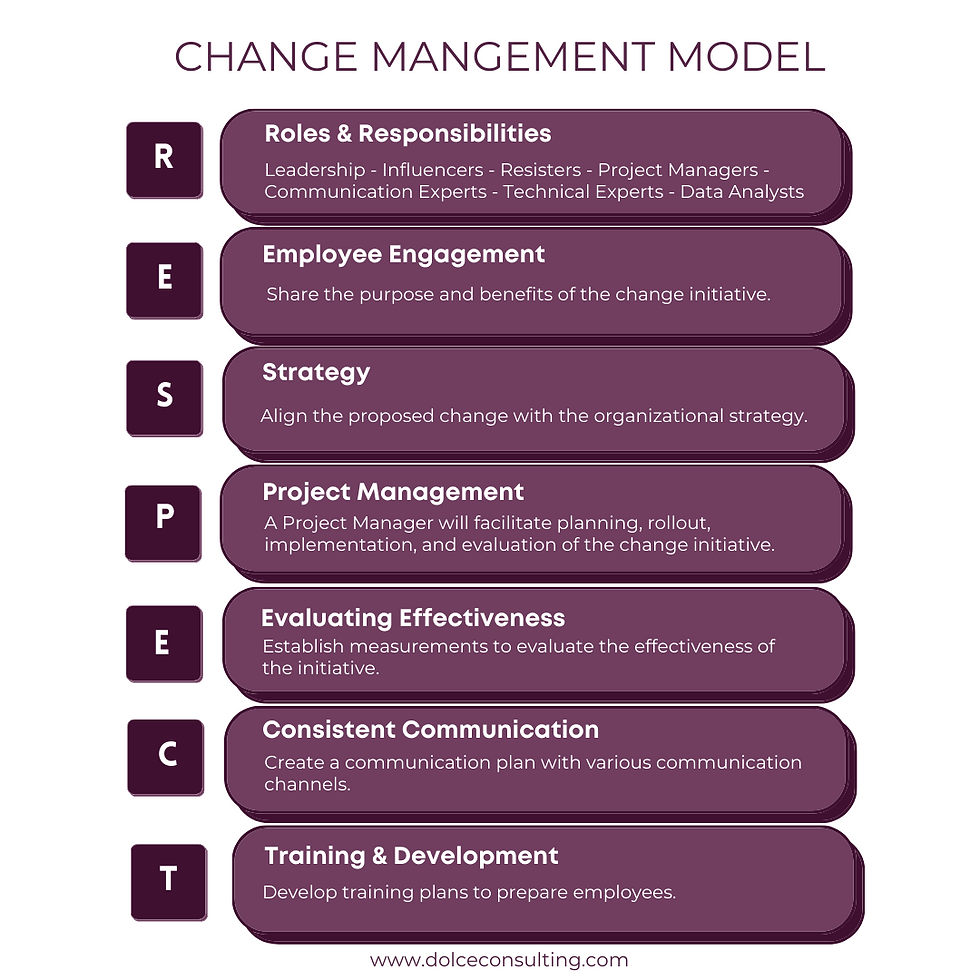Effective Change Management: Involving People for Successful Transitions

Successful change management involves respecting people's roles and engaging them throughout the transition process. Unlike change itself, which can be quick, discomfort and resistance often arise during the transition. To ensure a smooth change initiative, I have developed the RESPECT Model of Change/Transition Management. This model focuses on Roles & Responsibilities, Employee Engagement, Strategy, Project Management, Evaluating Effectiveness, Consistent Communication, and Training & Development.
Roles & Responsibilities:
To form a diverse and effective transition team, carefully select individuals for important roles such as leadership, influencers, resisters, project managers, communication experts, subject matter experts, process improvement experts, and data analysts. Each role brings valuable perspectives and skills necessary for successful change implementation. Also, make sure everyone on the project team is clear on their role in the project and what they are specifically responsible for. Clarity on roles and responsibilities will help reduce confusion and conflict during the project.
Employee Engagement:
Understanding that the stages of transition can be similar to the stages of grief (denial, anger, bargaining, depression, and acceptance), it's crucial to acknowledge and address the discomfort employees may experience. Share the purpose and benefits of the change initiative, emphasizing intrinsic motivation. Recognize resistance as a form of engagement, as it indicates employees' investment in the process. Explore their concerns, channel them into momentum, and set clear expectations about negotiable and non-negotiable aspects of the change.
Strategy:
Aligning the proposed change with the organizational strategy is vital for effective change management. Consider the who, what, when, where, why, and how of the change. Identify stakeholders, define the purpose and success criteria, determine the implementation timeline and locations affected, communicate the value of the change, and evaluate its impact on the organization, employees, and customers.
Project Management:
Assigning a project manager ensures effective coordination and accountability, even for smaller-scale changes. Underestimating the impact of change can lead to significant losses. A project manager will facilitate the planning, rollout, implementation, and evaluation of the change initiative, ensuring its successful execution.
Evaluating Effectiveness:
To avoid repeated failures and sustain change, establish measurements to evaluate the effectiveness of the initiative. A data analyst can provide valuable insights by monitoring key indicators, return on investment (ROI), and identifying any loss of momentum post-implementation. Strategic thinking is essential in defining success criteria and continuously monitoring the change's sustainability.
Consistent Communication:
Utilize various communication channels throughout the change initiative. Develop a comprehensive communication plan that includes regular updates, announcements, and feedback mechanisms. Effective communication ensures that employees remain informed, engaged, and aligned with the change initiatives.
Training & Development:
The workforce's ability to adapt and implement the change is critical. Assess the impact on systems, processes, and job functions. Develop training plans to equip employees with the necessary skills and knowledge. Consider both current and future employees to ensure sustainable results.
Partner with Dolce Consulting for successful change management in your organization. By following the RESPECT Model and involving people throughout the transition, you can achieve positive and lasting change.
Rebecca Johnson
Organization Development Consultant
Executive / Career Coach






Comments